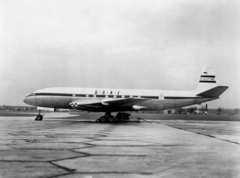 G-ALYP, the BOAC de Havilland Comet 1 involved in the accident | |
| Accident | |
|---|---|
| Date | 10 January 1954 |
| Summary | In-flight metal fatigue failure leading to explosive decompression and mid-air break-up |
| Site | Mediterranean Sea off Elba 42°40′42″N 10°25′38″E / 42.67833°N 10.42722°E |
| Aircraft | |
| Aircraft type | de Havilland DH-106 Comet 1 |
| Operator | British Overseas Airways Corporation |
| Registration | G-ALYP |
| Flight origin | Kallang Airport, Singapore |
| 1st stopover | Don Mueang Airport, Bangkok, Thailand |
| 2nd stopover | Rangoon Airport, Rangoon, Burma[1] |
| 3rd stopover | Dum Dum Airport, Calcutta, India |
| 4th stopover | Jinnah Airport, Karachi, Pakistan |
| 5th stopover | Bahrain Airport, Muharraq, Bahrain |
| 6th stopover | Beirut Airport, Beirut, Lebanon |
| Last stopover | Ciampino Airport, Rome, Italy |
| Destination | London Heathrow Airport, London, England |
| Occupants | 35 |
| Passengers | 29 |
| Crew | 6 |
| Fatalities | 35 |
| Survivors | 0 |
BOAC Flight 781 was a scheduled British Overseas Airways Corporation passenger flight from Singapore to London. On 10 January 1954, a de Havilland Comet passenger jet operating the flight suffered an explosive decompression at altitude and crashed, killing all 35 people on board.
The aircraft, registered G-ALYP,[2] had taken off shortly before from Ciampino Airport in Rome, en route to Heathrow Airport in London, on the final leg of its flight from Singapore. After it exploded, the debris from the explosion fell into the sea near the island of Elba, off the Italian coast.
G-ALYP was the third Comet built.[3] Its loss marked the second in a series of three fatal accidents involving the Comet in less than twelve months, all caused by structural failures; it followed the crash of BOAC Flight 783 near Calcutta, India, in May 1953, and was followed by the loss of South African Airways Flight 201 in April 1954, which crashed in circumstances similar to 781 after departing from Ciampino Airport.
- ^ "Jet Crash Off Italy Kills 35". The New York Times. 11 January 1954. pp. 1, 4.
- ^ "G-INFO Database". Civil Aviation Authority.
- ^ "First of the Fleet". Flight and Aircraft Engineer. Vol. LIX, no. 2201. 30 March 1951. p. 361. Retrieved 12 January 2018.